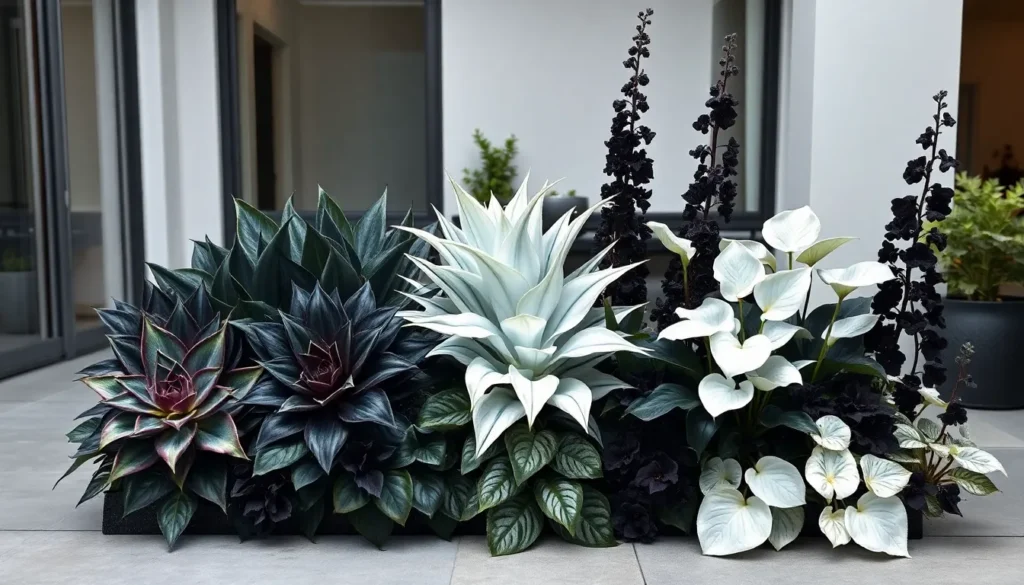We’ve all admired vibrant garden blooms and lush green foliage, but there’s something undeniably striking about plants that embrace a monochromatic palette. Black and white plants offer a sophisticated elegance that transforms any space into a dramatic showcase of natural artistry.
These remarkable specimens aren’t just rare curiosities – they’re powerful design tools that create stunning visual contrast and timeless appeal. From the deep, almost-black petals of certain tulips to the pristine white blooms of gardenias, monochromatic plants bring a unique sophistication that colored varieties simply can’t match.
Whether you’re designing a minimalist garden space or looking to add dramatic flair to your home, black and white plants offer endless possibilities. We’ll explore the most captivating varieties, share expert growing tips, and show you how to incorporate these stunning plants into your industry for maximum impact.
Black Prince Echeveria: The Gothic Beauty of Succulents
Black Prince Echeveria stands as one of nature’s most dramatic performers in the black and white plant collection. This stunning succulent transforms any space with its deep, mysterious coloring and architectural form.
Dark Purple-Black Rosettes That Command Attention
We’ve discovered that Black Prince Echeveria produces some of the darkest foliage in the succulent industry. The rosettes emerge as deep burgundy and gradually darken to an almost black purple hue when grown in full sun conditions.
Each rosette measures 3 to 4 inches across at maturity and forms perfect geometric patterns. The leaves develop their richest coloration during cooler months and when exposed to bright light for 6 to 8 hours daily.
We notice the plant creates striking offsets that cluster around the mother plant. These baby rosettes maintain the same dark coloring and create dramatic groupings that resemble gothic art installations.
The leaf edges often display subtle red margins that add depth to the overall black appearance. This natural highlighting effect becomes more pronounced during temperature fluctuations between day and night.
Low-Maintenance Care Requirements for Busy Gardeners
We recommend Black Prince Echeveria for gardeners who want maximum visual impact with minimal effort. This succulent thrives in well-draining soil and requires watering only when the soil completely dries out.
Care Requirements Table:
| Aspect | Requirement |
|---|---|
| Sunlight | 6-8 hours direct sun |
| Watering | Every 7-10 days in summer |
| Soil Type | Well-draining cactus mix |
| Temperature | 65-75°F optimal range |
| Fertilizer | Monthly during growing season |
Overwatering poses the biggest threat to these plants, so we suggest the “soak and dry” method. Water thoroughly until drainage occurs, then wait until soil feels completely dry before the next watering session.
We’ve found that Black Prince Echeveria tolerates neglect better than most houseplants. The succulent stores water in its thick leaves and can survive extended periods without attention.
Perfect for Modern and Minimalist Garden Designs
We incorporate Black Prince Echeveria into contemporary landscapes where its bold form creates focal points. The plant’s geometric structure complements clean lines and modern architectural elements beautifully.
These succulents work exceptionally well in monochromatic color schemes alongside white stones, concrete planters, and silver foliage plants. We often pair them with white sand or light colored mulch to enhance the dramatic contrast.
Container gardening showcases Black Prince Echeveria’s striking appearance most effectively. We recommend using white, gray, or black pots that won’t compete with the plant’s natural beauty.
The compact size makes these succulents ideal for small spaces, tabletop displays, and urban balcony gardens. We’ve successfully used them in rock gardens, succulent walls, and as accent plants in larger industry compositions.
White Ghost Plant: Ethereal Elegance in Your Garden
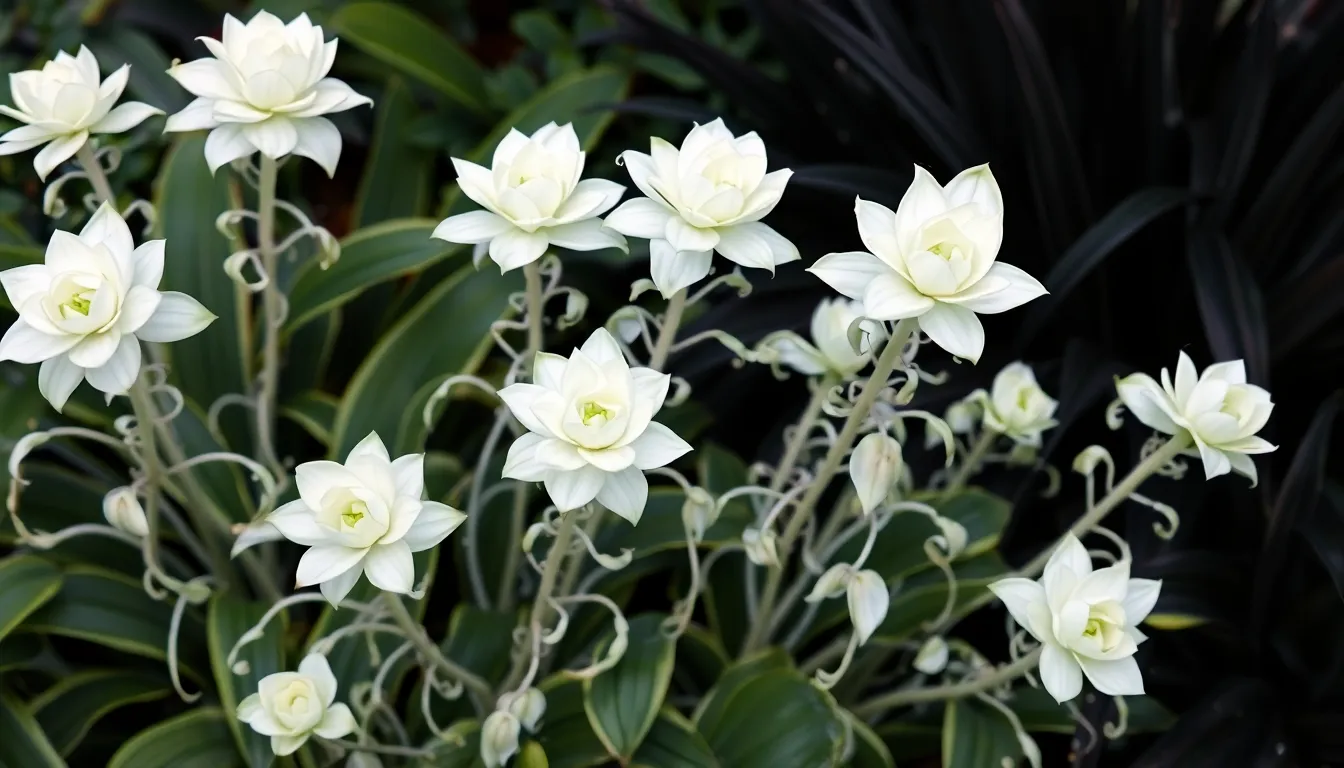
White ghost plants bring an otherworldly beauty to our gardens with their distinctive pale, silvery appearance. These remarkable succulents create magical focal points that complement the dramatic black varieties we’ve explored.
Silvery-White Foliage That Glows in Moonlight
Graptopetalum paraguayense captivates us with its ghostly, silvery-white leaves that seem to illuminate in moonlight. The plant’s fleshy, pointed leaves are coated with a powdery substance called pruinose, giving them their ethereal pale blue-gray appearance that transforms ordinary garden spaces into mystical landscapes.
Growing 6–12 inches tall and spreading 14–20 inches wide, this stunning succulent forms elegant rosettes with trailing stems that cascade beautifully from containers. Star-shaped white flowers with delicate red markings emerge in mid-spring, adding another layer of spectral beauty to our gardens.
Euphorbia lactea ‘White Ghost’ offers a dramatically different ghostly presence with its striking white skeletal branches that resemble otherworldly sculptures. These pale green to almost ghostly white branches create architectural interest that stands out particularly well in evening hours when their silhouette becomes most pronounced.
Drought-Tolerant Properties for Water-Wise Landscaping
Extreme drought tolerance makes white ghost plants perfect for our water-wise gardening goals. We only need to water these remarkable plants when the soil is completely dry, making them ideal for busy gardeners or regions with water restrictions.
Both varieties thrive in well-draining, sandy cactus or succulent mix that prevents root rot. Graptopetalum paraguayense can tolerate temperatures as low as 10°F, while Euphorbia lactea ‘White Ghost’ prefers warmer conditions between 65-85°F and becomes sensitive below 50°F.
Overwatering poses the greatest threat to these resilient plants, so we recommend following the “less is more” approach to irrigation. Their natural adaptation to arid conditions means they store water efficiently in their leaves and stems.
Stunning Contrast When Paired with Dark Plants
Creating dramatic visual impact becomes effortless when we pair white ghost plants with darker varieties like Black Prince Echeveria. The silvery-white foliage provides striking contrast that makes both plant types appear more vivid and defined in our garden compositions.
Positioning these ethereal beauties near deep purple, black, or dark green plants creates natural focal points that draw the eye throughout our industry design. The powdery, ghostly appearance of white ghost plants becomes even more pronounced when surrounded by plants with rich, saturated colors.
Container arrangements benefit tremendously from this monochromatic pairing, allowing us to create sophisticated displays that work equally well indoors and outdoors. The combination offers year-round interest since both plant types maintain their distinctive coloring through seasonal changes.
Black Pearl Ornamental Pepper: Dramatic Foliage and Fruit
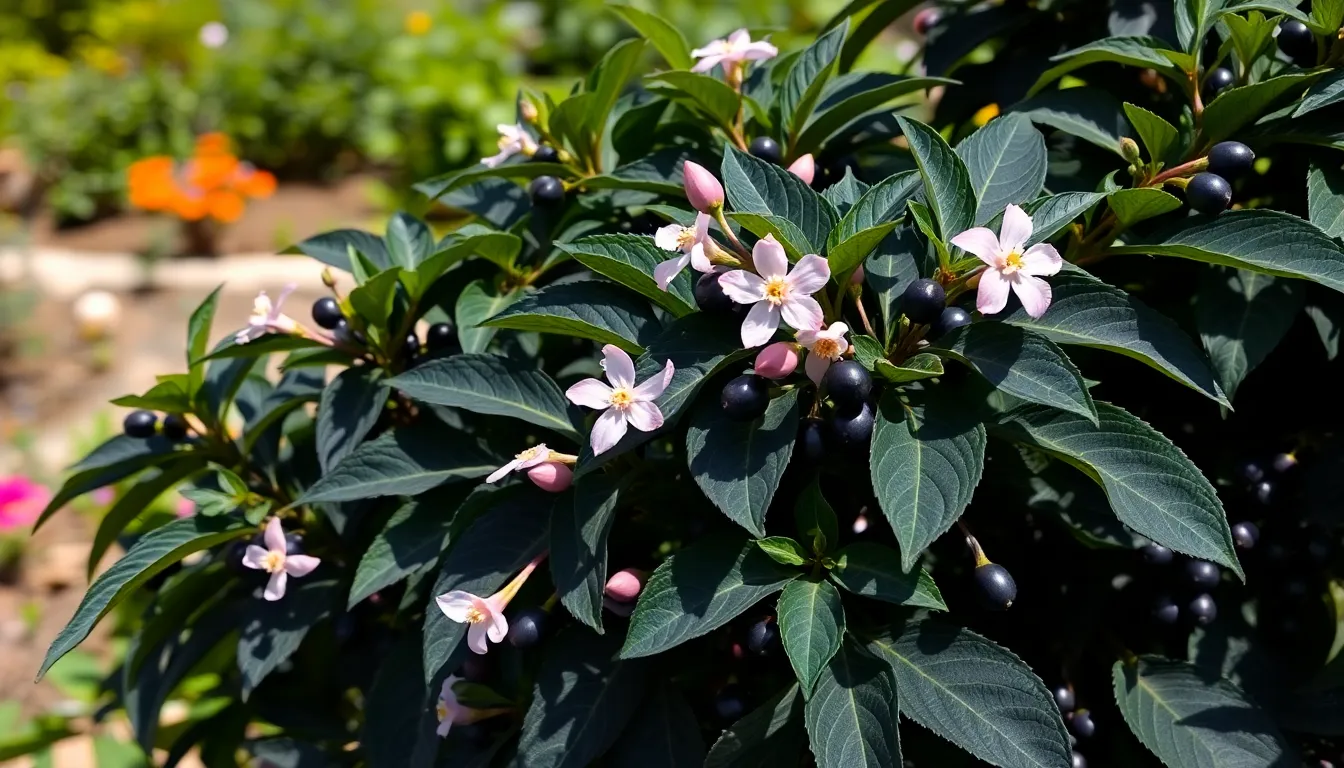
We’ve discovered another exceptional black and white plant that transforms gardens with its striking dual appeal. This award-winning cultivar earned the All-Americas Selections award in 2006 for its outstanding beauty and garden performance.
Jet-Black Leaves with Contrasting White Flowers
Jet-black foliage creates an extraordinary foundation for this ornamental pepper’s visual drama. The glossy leaves emerge green initially but transform into deep jet-black coloration when exposed to sunlight and heat. This remarkable color transformation makes the Black Pearl particularly captivating as it develops throughout the growing season.
White to lilac flowers provide a stunning contrast against the dark foliage backdrop. These delicate blooms appear regularly throughout the growing season, creating an ongoing display of light against dark. The contrast becomes even more pronounced as the black leaves reach their full intensity, making the white flowers appear almost luminous.
Shiny, round black fruit follows the flowering phase, maintaining the plant’s dramatic color scheme. These ornamental peppers eventually mature to deep red, adding another layer of visual interest to the display. The fruit’s glossy surface reflects light beautifully, improving the overall ornamental value of this unique pepper variety.
Edible Black Peppers That Add Culinary Value
Edible peppers pack important heat even though their ornamental appearance. The Black Pearl peppers register between 10,000 to 30,000 Scoville Heat Units, making them 4 to 12 times hotter than jalapeño peppers. This heat level places them in the medium-hot category for culinary enthusiasts seeking both beauty and spice.
Citrus undertones distinguish these peppers from typical hot varieties. The unique flavor profile combines the expected heat with bright, citrusy notes that enhance various dishes. Chefs and home cooks appreciate this dual-purpose plant for its ability to serve as both garden ornament and cooking ingredient.
Culinary applications extend beyond simple heat addition to dishes. The peppers work particularly well in hot sauces, spice blends, and dishes requiring both visual appeal and moderate heat. Their ornamental quality makes them excellent garnishes for plates where presentation matters as much as flavor.
Annual Growth Habit Perfect for Seasonal Displays
Annual growth patterns make the Black Pearl ideal for seasonal garden refresh. This Capsicum annuum cultivar grows 14 to 18 inches tall with a bushy, upright, and well-branched habit. The compact size fits perfectly in containers, raised beds, or as border plants in traditional garden settings.
Heat tolerance ensures reliable performance throughout summer months. The plant requires minimal water and fertilizer while thriving in full sun conditions. This low-maintenance characteristic makes it accessible to gardeners of all experience levels who want dramatic results without intensive care requirements.
Container growing maximizes the plant’s ornamental potential for patios and indoor spaces. The compact growth habit and striking appearance make it perfect for decorative pots where its black foliage can create focal points. Seasonal replacement keeps gardens fresh and allows for creative color combinations with other annual plants.
White Caladium: Heart-Shaped Leaves with Monochrome Appeal
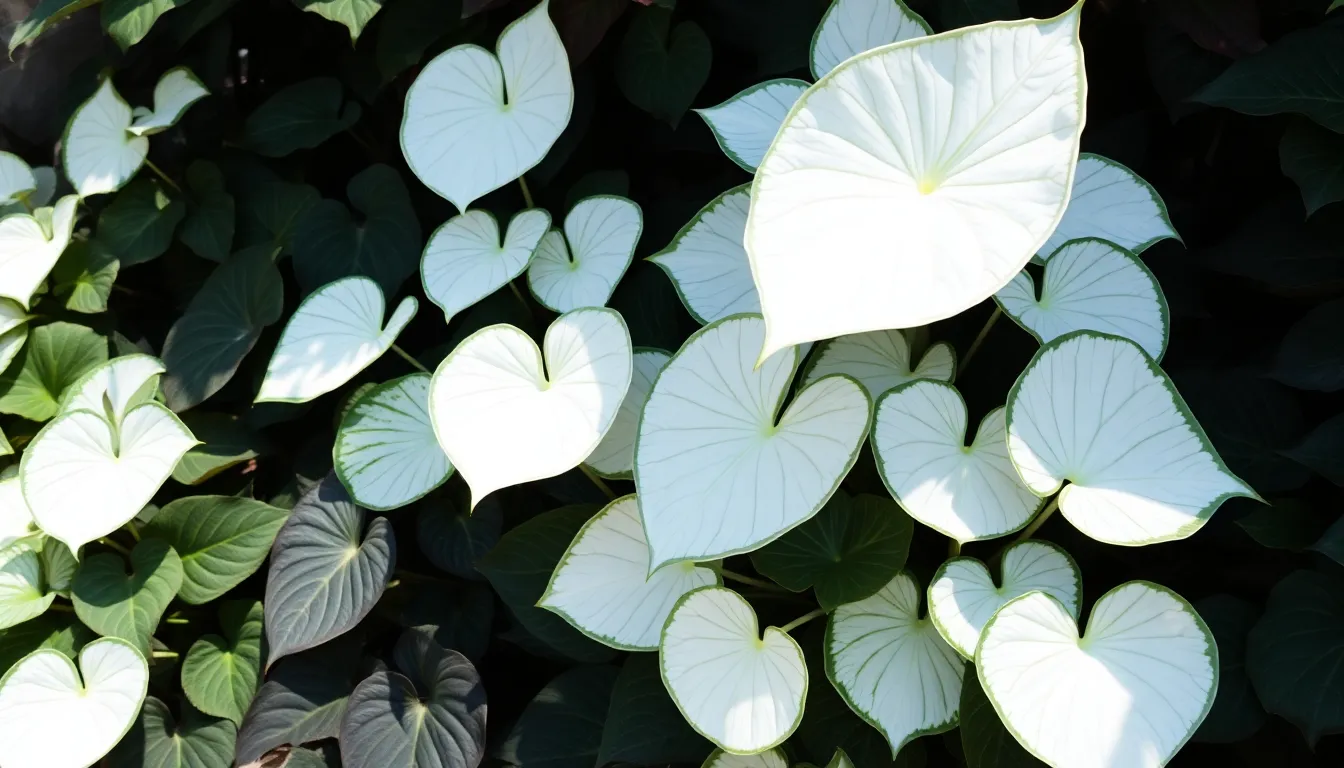
White Caladiums stand out as stunning additions to our monochrome plant collection, featuring distinctive heart-shaped leaves that create instant visual impact. Their predominantly white foliage often includes subtle green or silver veining, making these plants perfect for gardeners seeking elegant contrast in their outdoor and indoor spaces.
Pure White Varieties for Shade Garden Elegance
Pure white varieties like ‘White Christmas’ offer almost completely white leaves that transform shaded garden areas into bright, sophisticated focal points. These elegant plants thrive in part shade conditions, requiring only 4-6 hours of indirect sunlight daily to maintain their striking appearance. We recommend planting them in temperatures consistently above 60°F, as prolonged exposure to cold below 45°F can damage their delicate foliage.
Shade gardens benefit tremendously from White Caladiums because their light-reflecting leaves brighten dark corners without competing with surrounding plants. Gardens featuring these monochrome beauties create sophisticated outdoor spaces that feel both dramatic and serene. Container arrangements work exceptionally well with these varieties, allowing us to move them to optimal locations throughout the growing season.
Indoor Growing Tips for Year-Round Enjoyment
Indoor White Caladiums require consistent moisture management, with weekly watering when the soil surface feels dry to the touch. We avoid overwatering these plants because excess moisture leads to yellowing leaves and potential root problems. Winter dormancy periods call for reduced watering schedules to prevent stress on the plant.
High humidity levels are essential for healthy indoor growth, which we achieve through regular misting, humidifiers, or pebble trays filled with water. Dry air from heating vents can quickly dehydrate these tropical plants, so proper placement away from direct airflow is crucial. Controlled-release fertilizers or liquid fertilizers diluted to quarter strength provide adequate nutrition without burning the sensitive white foliage.
Companion Planting with Dark-Leafed Varieties
Companion planting with dark foliage plants creates the most dramatic visual contrast in our black and white plant designs. We pair White Caladiums with deep purple-leafed or black foliage plants to achieve stunning monochrome garden themes that capture attention from every angle. Their bright white leaves reflect light beautifully against darker companion plants, creating depth and richness in garden compositions.
Container arrangements benefit from this classic plant pairing strategy, where we combine light and dark elements for maximum visual impact. Shade gardens transform into sophisticated outdoor rooms when we use these contrasting foliage colors together. Indoor displays also benefit from this design principle, creating eye-catching combinations that work well in modern and traditional home decor settings.
Black Petunia: Velvety Flowers That Stop Traffic
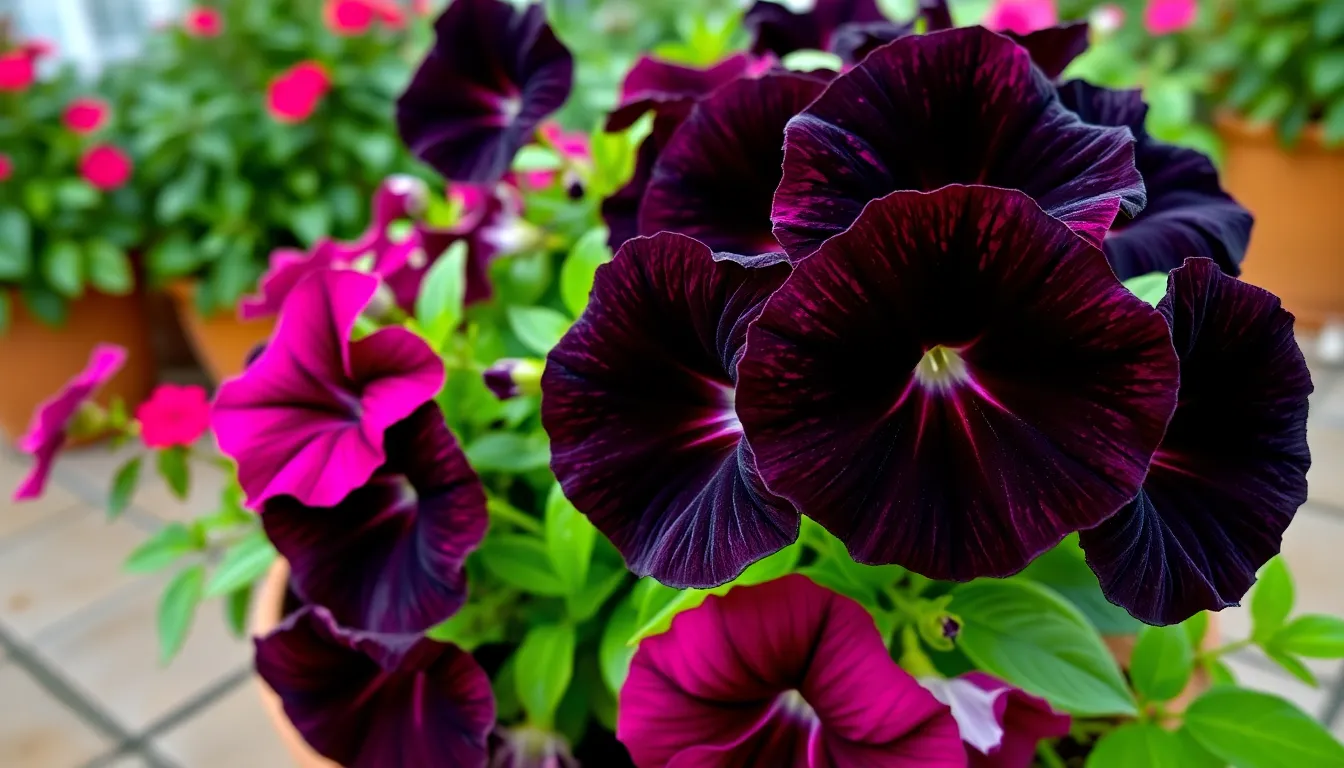
Black petunias deliver dramatic sophistication to gardens with their nearly black blooms that create stunning focal points. We’ve discovered these captivating flowers offer unmatched elegance for gardeners seeking bold visual statements.
Near-Black Blooms That Create Visual Drama
STARLET™ Velvet Petunia produces rich, velvety black blooms with dark purple undertones that immediately capture attention. This variety reaches 8-10 inches in height while spreading 12-20 inches wide, creating perfect mounded displays. During summer heat, these flowers develop deep purple magenta hues that add seasonal color variation to your displays.
Phantom Black Velvet Petunia showcases luxurious black-purple petals with rounded, slightly ruffled flower shapes that appear almost otherworldly. We recommend positioning this variety in moonlit or evening gardens where its deep hue creates maximum impact. These blooms offer sophisticated elegance that transforms ordinary garden spaces into dramatic showcases.
Crazytunia® Black Mamba Petunia features large, jet-black trumpet-shaped flowers that bloom from mid-spring to late summer. Growing as a dense, mounded annual about 10 inches tall, this variety eliminates maintenance concerns with its self-cleaning properties. Weather stress tolerance makes Black Mamba particularly reliable for continuous seasonal displays.
Continuous Flowering Throughout the Growing Season
Moderate watering combined with weekly fertilizing ensures these black petunias maintain continuous blooms throughout their growing period. We’ve found that full sun exposure maximizes both flower production and color intensity in most varieties. Deadheading encourages more blooms in varieties like STARLET™ Velvet, while Crazytunia® Black Mamba requires no deadheading due to its self-cleaning nature.
These petunias attract butterflies and hummingbirds, creating ever-changing garden ecosystems that enhance seasonal interest. Their hardy nature in zones 10-11 provides reliable performance in suitable climates. Weather stress tolerance in varieties like Black Mamba ensures consistent flowering even during challenging growing conditions.
Container Gardening Applications for Patios and Balconies
Container gardening showcases black petunias’ compact habits perfectly, making them ideal for borders, hanging baskets, and patio displays. We position these varieties as focal points in mixed container designs where their dramatic blooms create sophisticated centerpieces. Their 12-20 inch spread in containers provides excellent coverage without overwhelming smaller spaces.
Pairing black petunias with white or bright-colored flowers creates striking visual contrast that enhances both container and garden compositions. These combinations work especially well on patios and balconies where close viewing allows appreciation of subtle color variations. Their continuous blooming habit ensures season-long displays that maintain visual interest in container arrangements.
Spiller applications in mixed designs allow black petunias to cascade dramatically over container edges. We recommend using them as fillers between taller plants to create layered displays with sophisticated color transitions. Their compact growth makes them perfect for apartment gardening and small-space applications where maximum visual impact is essential.
Dusty Miller: Silver-White Foliage for Textural Interest
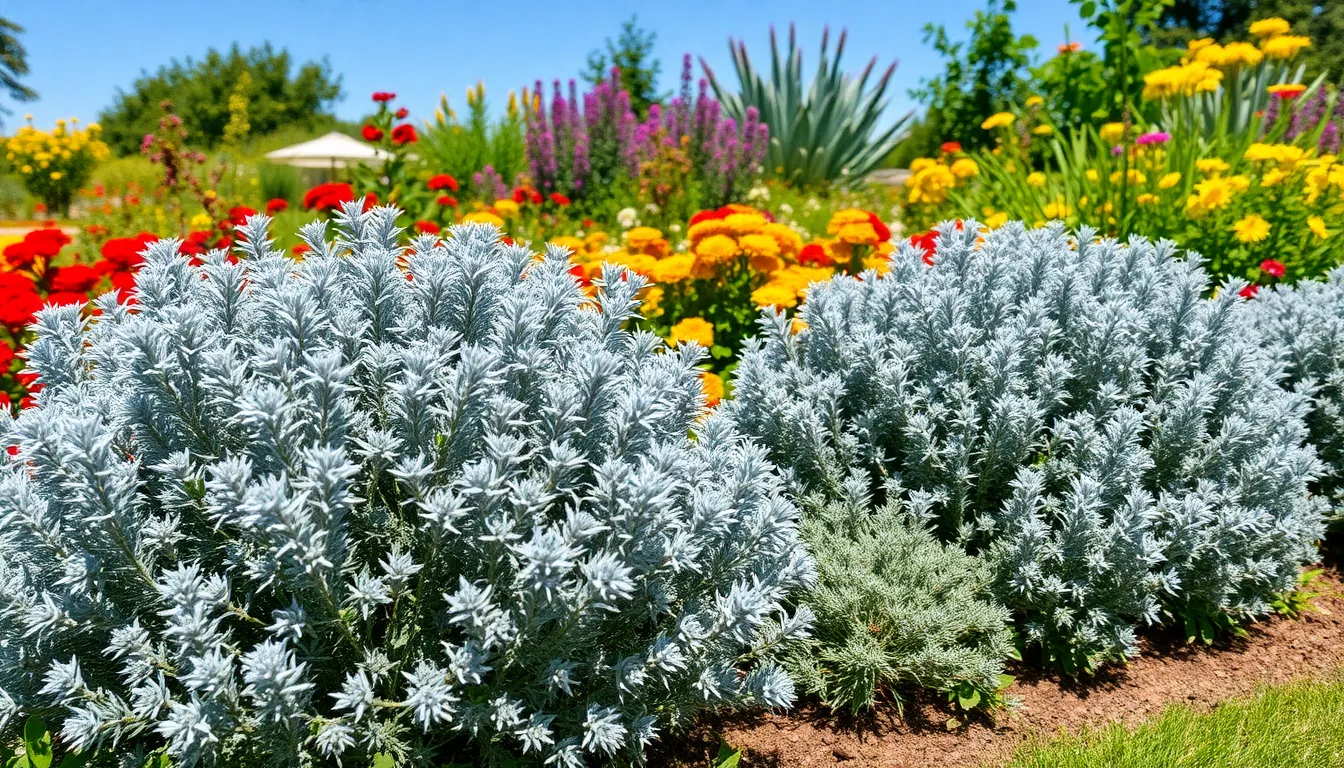
Dusty Miller (Senecio cineraria) stands out as one of our most beloved silver-white plants for creating sophisticated textural contrasts in garden designs. This versatile perennial brings elegant silvery-gray foliage that enhances any planting scheme while maintaining exceptional garden performance.
Silvery-Gray Leaves That Complement Any Color Scheme
Silvery-gray foliage makes Dusty Miller an incredibly versatile design element that works with virtually any color palette. The soft, velvety leaves create a neutral backdrop that allows vibrant flowers to pop while providing sophisticated contrast against darker foliage plants. We’ve found that this adaptability stems from the plant’s unique ability to bridge warm and cool color schemes effortlessly.
Textural interest becomes particularly pronounced when we combine Dusty Miller’s fine, dissected leaves with broader-leafed companions. The silvery tones reflect light beautifully, creating luminous effects that brighten shadowy areas of the garden. Garden designers often rely on this characteristic to create cohesive plantings that feel intentional rather than random.
Versatile Uses in Borders, Containers, and Cut Arrangements
Borders benefit tremendously from Dusty Miller’s consistent form and reliable performance throughout the growing season. We recommend using it as an edging plant where its compact 6-12 inch height creates clean lines without overwhelming neighboring plants. The silver foliage provides excellent definition between different garden sections while maintaining visual flow.
Container gardening becomes more sophisticated when we incorporate Dusty Miller as a thriller, filler, or spiller element. Its drought tolerance makes it particularly valuable in mixed containers where watering needs vary among different plants. We’ve observed that it pairs exceptionally well with both bold, colorful annuals and subtle, monochromatic schemes.
Cut flower arrangements gain professional polish when we include Dusty Miller’s silvery stems and foliage. Florists value this plant because it provides neutral texture that doesn’t compete with focal flowers while adding substantial visual weight to arrangements. The foliage also has excellent vase life, often lasting longer than many traditional cut flowers.
Heat and Drought Tolerance for Challenging Conditions
Heat tolerance makes Dusty Miller an exceptional choice for challenging garden conditions where other silver-foliaged plants might struggle. We’ve successfully grown this plant in temperatures exceeding 90°F with minimal stress, making it ideal for southern gardens and hot, sunny exposures. The thick, fuzzy leaves help protect the plant from intense sunlight while reducing water loss through transpiration.
Drought resistance becomes apparent once Dusty Miller establishes its root system, typically within 4-6 weeks of planting. We recommend deep, infrequent watering to encourage strong root development rather than frequent shallow watering. This approach helps the plant develop the resilience needed for extended dry periods.
Challenging environments like coastal gardens, rocky slopes, and areas with poor soil drainage become more manageable when we include Dusty Miller in our plant selections. The plant’s Mediterranean origins have equipped it to handle salt spray, alkaline soils, and other difficult conditions that limit our options for silver-foliaged plants. We’ve found it particularly valuable for xeriscaping projects where water conservation is a priority.
Black Dahlia: Bold Blooms for Statement Gardens
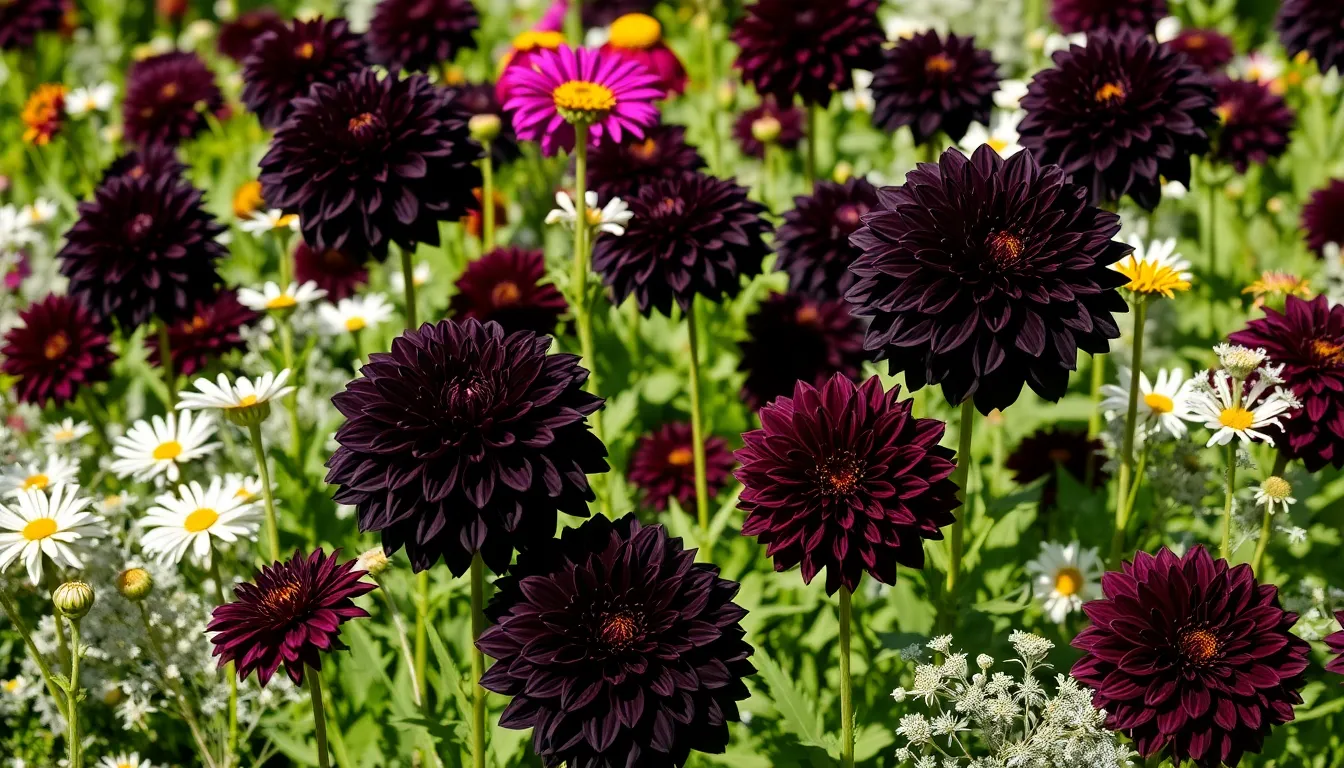
We’ve discovered that black dahlias represent the ultimate drama in monochromatic gardening, offering gardeners an opportunity to create stunning focal points with their nearly black blooms. These remarkable flowers bring sophisticated elegance to any industry design through their mysterious dark coloration and diverse forms.
Deep Burgundy-Black Petals with Velvet Texture
Dark burgundy petals create the illusion of true black coloration through deep purple-red hues that absorb light and appear nearly ebony in garden settings. The velvet texture of these blooms adds tactile appeal that complements their visual drama, making each flower feel as luxurious as it looks. Rich maroon undertones become visible in bright sunlight, revealing the complex color depth that makes black dahlias so captivating for both gardeners and floral designers.
Symbolic meanings associated with these dark blooms include elegance, dignity, mystery, and creativity, though their connection to historical events has also linked them to themes of betrayal and sadness. We find that their dramatic appearance evokes feelings of magic and unattainable beauty, making them perfect conversation starters in garden spaces. Their sophisticated coloration pairs beautifully with lighter companions like white cosmos or silver dusty miller for maximum contrast impact.
Various Flower Forms from Dinner Plate to Pompon
Large dinner plate varieties showcase massive blooms that can reach impressive sizes, creating bold statement pieces in garden borders and industry designs. These oversized flowers command attention and work exceptionally well as focal points in formal garden arrangements. Smaller pompon forms offer charming, compact blooms that provide delicate contrast to their giant cousins while maintaining the same dramatic coloration.
Diverse flower shapes within the black dahlia family include decorative, cactus, and ball types, each offering unique petal arrangements and growth habits for different garden applications. We recommend mixing various forms throughout garden beds to create visual interest and textural variety. Their upright stature and varied bloom sizes make them excellent choices for both cutting gardens and permanent industry installations.
Tuber Storage and Overwintering Techniques
Underground tubers require careful winter storage in colder climates where frost threatens their survival, making proper preparation essential for perennial success. We dig up tubers after the first frost kills the foliage, then clean off excess soil and allow them to dry in a well-ventilated area for several days. Storing them in slightly damp peat moss or vermiculite in a cool, dark location between 40-50°F ensures they remain viable through winter months.
Spring replanting of stored tubers begins when soil temperatures consistently reach 60°F and danger of frost has passed in your growing zone. We recommend inspecting stored tubers for signs of rot or damage before planting, discarding any that appear compromised. Proper storage techniques ensure these dramatic blooms return year after year, making black dahlias a worthwhile investment for gardeners seeking bold, recurring color in their monochromatic plant collections.
White Coleus: Variegated Foliage for Shade Gardens
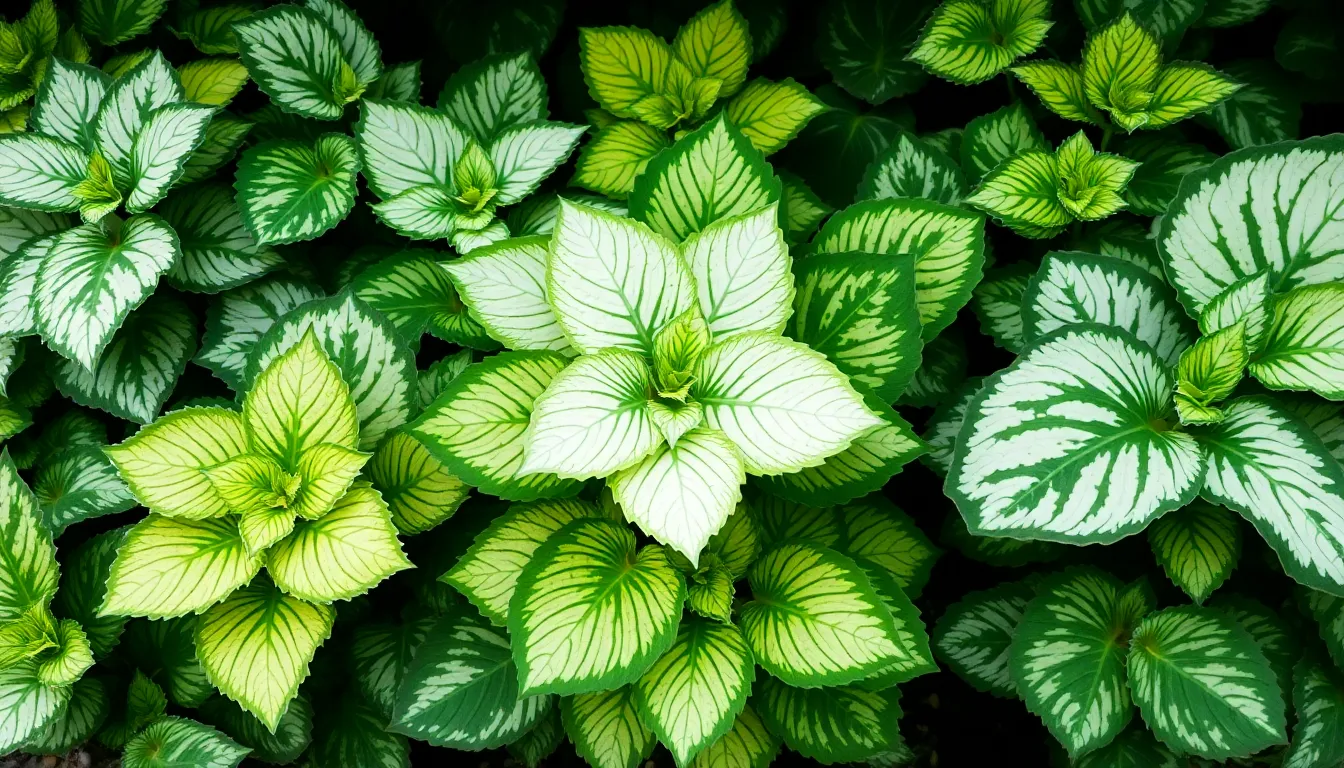
White coleus stands out as one of the most versatile black and white plants for gardeners seeking dramatic foliage in challenging shaded areas. These distinctive plants feature striking green and white variegated leaves that create visual interest where traditional flowering plants might struggle to thrive.
Green and White Leaf Patterns That Brighten Dark Areas
Variegated coleus varieties offer an impressive range of green and white leaf combinations that transform dark garden corners into vibrant focal points. The patterns range from scalloped edges to ruffled textures, with some varieties showcasing quilted surfaces that add dimensional interest to shade plantings.
Different cultivars display unique variegation styles, including cream colored margins, white centers with green edges, and marbled patterns that blend both colors seamlessly. These contrasting leaf patterns provide a brightening effect that rivals flowering plants in their ability to illuminate low light environments.
The foliage creates excellent contrast against darker garden backgrounds, making it perfect for layered plantings where we want to add texture without relying on blooms. Many varieties maintain their striking appearance throughout the growing season, providing consistent visual impact from spring through fall.
Easy Propagation Methods for Expanding Your Collection
Stem cutting propagation makes expanding your white coleus collection incredibly straightforward and cost effective. We can multiply our favorite varieties by cutting healthy stems just below a node, which encourages rapid root development.
Removing lower leaves from the cutting prevents rot while the plant establishes its root system. The prepared cutting can be placed directly in water or moist soil, with roots typically forming within 7 to 14 days under proper conditions.
This simple propagation method allows us to create multiple plants from a single parent, making it easy to fill larger garden areas or share varieties with fellow gardeners. The fast rooting process means we can propagate throughout the growing season whenever we want to expand our collection.
Pinching and Pruning for Bushier Growth
Regular pinching of growing tips stimulates fuller, more compact plant growth by encouraging side shoot development throughout the season. This technique redirects the plant’s energy from upward growth to lateral branching, creating a bushier appearance.
Pruning leggy stems maintains the plant’s compact form while improving the overall foliage display quality. We should remove any flower spikes that appear, as this redirects energy back to leaf production and enhances the ornamental value of the variegated foliage.
The pinching process should be done consistently throughout the growing season, starting when plants reach 4 to 6 inches in height. This ongoing maintenance ensures our white coleus varieties maintain their attractive, full appearance rather than becoming tall and sparse.
Black Hollyhock: Cottage Garden Charm with Gothic Twist

We discover dramatic beauty in Black Hollyhock (Alcea rosea ‘Blacknight’), where traditional cottage garden aesthetics meet mysterious gothic elegance. This striking perennial transforms garden spaces with its nearly black blooms that create an unforgettable visual statement.
Dark Purple-Black Spires That Reach Skyward
Towering heights of 5 to 8 feet make Black Hollyhock an exceptional architectural element that commands attention in any garden setting. Deep maroon to nearly black flowers emerge as single or semi-double cup-shaped blooms with bright yellow centers, creating a stunning contrast against the dark petals. Tall flower spikes rise elegantly from basal rosettes of green foliage, establishing dramatic vertical interest that serves as perfect backdrops for lower-growing plants.
Sun-loving requirements include at least 6 hours of direct sunlight daily, while rich, moist, well-drained soil provides the foundation for optimal growth. Staking becomes necessary in windy locations to support these impressive spires, and light spring fertilizing encourages robust flower production. Average watering needs make maintenance manageable once plants establish their root systems in the garden.
Hardy perennial nature allows Black Hollyhock to tolerate challenging conditions including juglone from black walnut trees and periods of drought stress. Pruning flower stalks to 6-8 inches above ground after blooming extends the plant’s energy for future seasons while maintaining garden tidiness.
Self-Seeding Habits for Natural Garden Expansion
Natural reproduction occurs through prolific self-seeding that creates expanding colonies of dramatic black blooms year after year. Seeds develop in distinctive dried seed heads that provide seasonal interest even after flowers fade, adding structural elements to winter garden landscapes. Established plants readily scatter seeds throughout garden beds, allowing gardeners to enjoy spontaneous plantings in unexpected locations.
Garden planning benefits from understanding this self-seeding behavior, as we can strategically place parent plants where we want future generations to naturalize. Removing spent flowers before seed formation controls spread when precise placement is desired, while allowing some seed heads to mature ensures continued presence in the garden. Young seedlings transplant easily in early spring, giving us flexibility to relocate volunteers to preferred locations.
Maintenance becomes minimal once Black Hollyhock establishes its self-perpetuating cycle, reducing the need for annual replanting or extensive garden planning. This natural expansion creates the authentic cottage garden atmosphere where plants seem to grow effortlessly throughout the industry.
Traditional Uses in Historic and Heritage Gardens
Cottage garden traditions have featured hollyhocks for centuries, where Black Hollyhock adds gothic sophistication to time-honored planting schemes. Heritage gardens particularly value these plants for their historical authenticity and connection to traditional English garden design principles. Border plantings showcase Black Hollyhock’s dramatic presence against lighter colored perennials and annuals.
Wildlife attraction includes butterflies, hummingbirds, and bees that visit the nectar-rich flowers, supporting pollinator populations essential to heritage garden ecosystems. Traditional medicinal uses historically included hollyhock leaves and roots, though modern gardeners appreciate them primarily for ornamental value and ecological benefits.
Specimen plant potential makes Black Hollyhock ideal for featured positions in heritage garden designs where architectural plants create focal points. Companion planting with traditional cottage garden favorites like roses, delphiniums, and foxgloves enhances the authentic historical atmosphere while the black blooms provide unexpected drama among more conventional color palettes.
White Sweet Alyssum: Carpet of Tiny Fragrant Flowers
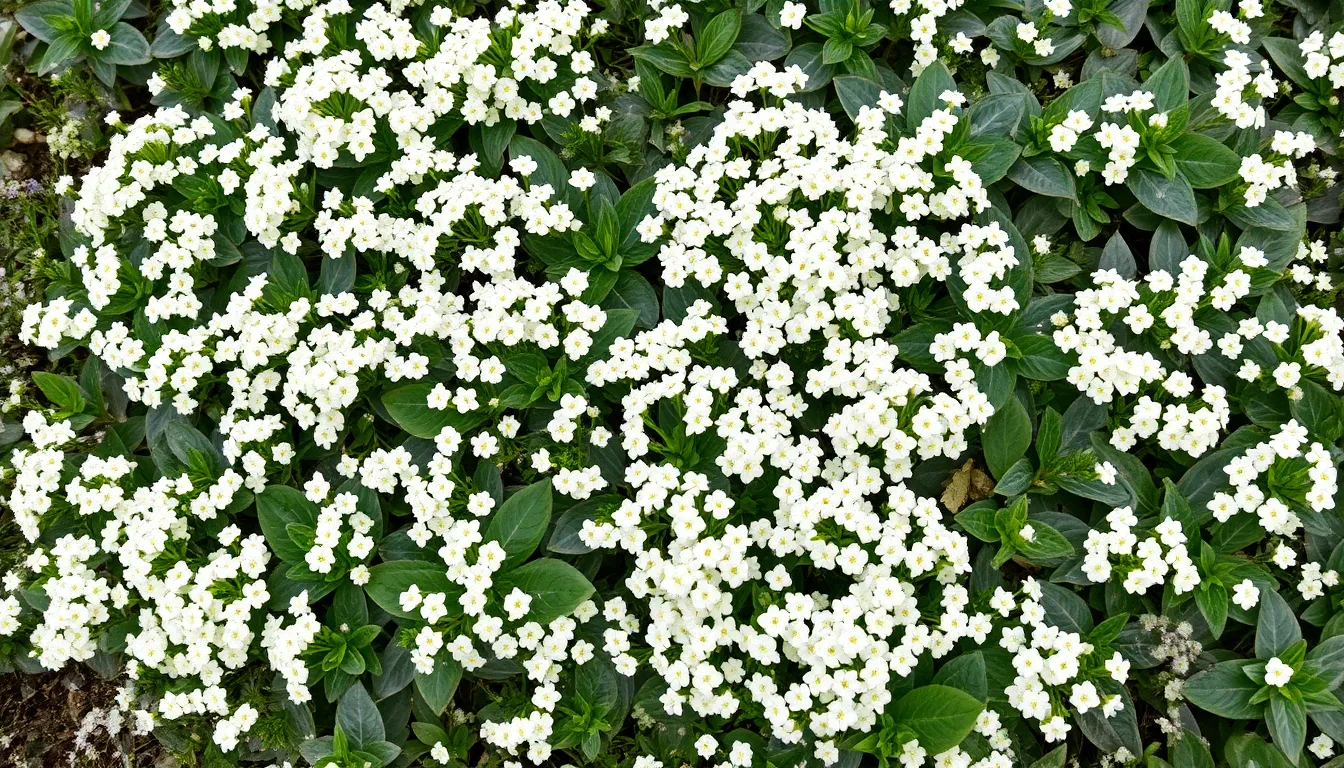
White Sweet Alyssum creates one of the most enchanting ground covers we’ve encountered in monochromatic gardening. This delicate beauty transforms any space into a fragrant white wonderland.
Dense Clusters of Pure White Blooms
Tiny flowers pack incredible visual impact when White Sweet Alyssum produces its signature cross-shaped blooms. Each flower measures just 8 to 12 millimeters in diameter with four rounded petals that cluster together densely. Hundreds of these miniature blossoms create a continuous carpet effect that rivals any traditional ground cover.
Fragrance becomes the standout feature as these small flowers release their sweet honey-like scent throughout the day. The gray-green, lance-shaped leaves provide the perfect backdrop for the pure white display. Dense growth habit ensures maximum flower production across the plant’s 12 to 14 inch spread.
Pollinator attraction makes this plant doubly valuable for our black and white garden themes. Bees and beneficial insects flock to the abundant nectar sources while we enjoy the visual drama of white flowers against darker companion plants.
Ground Cover Applications for Pathways and Borders
Pathways benefit tremendously from White Sweet Alyssum’s low-growing, mounding habit that stays just 3 to 10 inches tall. The plant’s spreading nature fills gaps between stepping stones and softens hard edges of walkways. Its shallow root system won’t interfere with paving or compete aggressively with nearby plants.
Border edging receives instant sophistication when we use Sweet Alyssum as a living border. The plant creates clean lines while providing seasonal color that contrasts beautifully with black varieties like Black Prince Echeveria or Black Pearl Ornamental Pepper. Mass plantings deliver the most dramatic impact for larger border areas.
Rock gardens and alpine settings showcase this versatile ground cover at its best. The plant’s tolerance for various soil types and environmental conditions makes it ideal for challenging locations. Container gardening enthusiasts appreciate its trailing habit as a “spiller” plant in mixed arrangements and hanging baskets.
Cool-Season Growing for Extended Bloom Periods
Spring emergence delivers the first flush of blooms when temperatures remain cool and comfortable. Sweet Alyssum thrives in USDA zones 5 through 9, performing best when daytime temperatures stay below 80°F. The plant’s European heritage makes it naturally adapted to cooler growing conditions.
Summer heat causes temporary dormancy but we shouldn’t worry about apparent decline during peak summer months. The plant conserves energy during hot periods and often rebounds with fresh growth as temperatures cool. Consistent moisture helps maintain some blooming even during warmer weather.
Fall revival creates spectacular displays that often surpass spring performance. Cool autumn temperatures trigger renewed flowering that can last until the first hard frost. The plant’s ability to self-seed ensures natural returns in favorable locations, creating effortless perennial-like behavior in our monochromatic gardens.
Conclusion
We’ve explored the captivating industry of black and white plants and discovered their incredible potential to transform any garden space. These monochromatic beauties offer endless possibilities for creating sophisticated designs that command attention and spark conversation.
Whether you’re drawn to the mysterious allure of Black Prince Echeveria or the ethereal beauty of White Ghost Plants our collection showcases varieties that suit every gardening style and skill level. From dramatic black dahlias to delicate sweet alyssum each plant brings its own unique character to your outdoor space.
We encourage you to experiment with these striking varieties and discover how they can elevate your garden’s visual impact. With proper care and thoughtful placement these black and white plants will reward you with years of stunning beauty and endless design inspiration.
Frequently Asked Questions
What are black and white plants and why are they popular?
Black and white plants are monochromatic varieties that create striking visual contrasts in gardens and home spaces. They’re popular because they serve as powerful design elements that enhance any environment, offering sophisticated elegance and architectural interest. These plants are perfect for modern, minimalist designs where their bold forms can serve as focal points.
What is Black Prince Echeveria and how do you care for it?
Black Prince Echeveria is a dramatic succulent featuring deep purple-black rosettes with architectural form. It thrives in well-draining soil with minimal watering, making it perfect for busy gardeners. This drought-tolerant plant prefers bright light and is ideal for modern garden designs where its bold appearance commands attention.
Which white plants are best for creating contrast in gardens?
White Ghost Plant varieties like Graptopetalum paraguayense and Euphorbia lactea ‘White Ghost’ are excellent choices. White Caladium offers heart-shaped leaves with predominantly white foliage, while White Sweet Alyssum provides delicate ground cover with fragrant clusters. Dusty Miller adds elegant silvery-gray foliage that complements any color scheme.
How do you grow black petunias successfully?
Black petunias like STARLET™ Velvet Petunia and Crazytunia® Black Mamba deliver nearly black blooms and thrive in containers. They prefer full sun to partial shade, well-draining soil, and regular watering. These dramatic flowers are perfect for seasonal displays and create sophisticated elegance in garden borders or hanging baskets.
What makes black dahlias special for garden design?
Black dahlias represent ultimate drama in monochromatic gardening with their nearly black, burgundy-tinted blooms. They offer sophisticated elegance and come in various forms from large dinner plate varieties to smaller pompon shapes. These flowers symbolize elegance and mystery, creating luxurious focal points in garden designs.
Can white coleus grow in shade?
Yes, White Coleus is perfect for shaded areas and features striking green and white variegated leaves that brighten dark garden corners. It’s easily propagated through stem cuttings and requires regular pinching to encourage bushier growth. This versatile plant thrives in partial to full shade conditions.
How tall do Black Hollyhocks grow?
Black Hollyhocks (Alcea rosea ‘Blacknight’) can reach heights of 5 to 8 feet, adding significant architectural interest to garden spaces. These striking perennials combine traditional cottage garden charm with gothic elegance, featuring nearly black blooms that create dramatic visual statements in heritage and modern gardens alike.
What are the benefits of White Sweet Alyssum?
White Sweet Alyssum creates dense clusters of tiny, fragrant white flowers that attract pollinators. Its low-growing habit makes it ideal for pathways and borders, while its cool-season preference allows extended blooming periods. The plant self-seeds naturally, ensuring returns in favorable garden locations.

